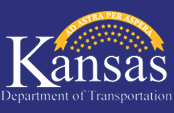ROUNDABOUTS
Imagine a unique intersection where:
There aren’t any stop signs or traffic lights
You don’t have to guess whose turn it is to move
Even if you have to wait there isn’t a long delay
There are fewer (and less severe) collisions than intersections with stop signs and traffic lights
This unique type of intersection exists in the form of roundabouts. They are a safe and effective alternative to stop signs or traffic signals for intersection traffic control. The first one in Kansas was built in Manhattan in 1997. By the end of 2009, over 70 can be seen on the state highway system with numerous others constructed by cities throughout Kansas.
What makes them unique?
Modern roundabouts in the U.S. are circular intersections with vehicles traveling counter-clockwise around a center island. Drivers entering a roundabout yield to vehicles already in the roundabout. Roundabouts require drivers to slow down, enter at the correct angle, and drive through the intersection in the same direction and at a consistent, slow speed. This promotes a smooth, steady flow of traffic that is safe and efficient without stop signs or traffic signals.
The following facts make these unique intersections a favorable means of traffic control:
Safety — A 2001 study by the Insurance Institute for Highway Safety of 23 intersections in the U.S. reported that replacing traffic signals or stop signs with roundabouts reduced injury crashes by 80 percent and all crashes by 40 percent. Subsequent studies have reported similar results. The reduction in crashes and crash severity is due to slower speeds, fewer conflict points, and vehicles traveling in the same direction.
Capacity — Roundabouts can often handle high traffic volumes and left turns more efficiently than intersections with traffic signals.
Reduced Delay— Yielding at the entry, rather than stopping and waiting at a stop sign or a red light, reduces travel delay.
Low Maintenance — Roundabouts eliminate the cost of maintaining traffic signals, saving about $3,500 per year per intersection. Reduced electricity costs can save approximately $1,500 per year per intersection.
Environmental — Reducing delays reduces idling, saves gas and lowers the amount of exhaust released into the air.
Aesthetics — The central island can be attractively landscaped.

Urban roundabout near expressway
See the video “Roundabouts in Kansas.”

Typical collision during left turn at signalized intersection

